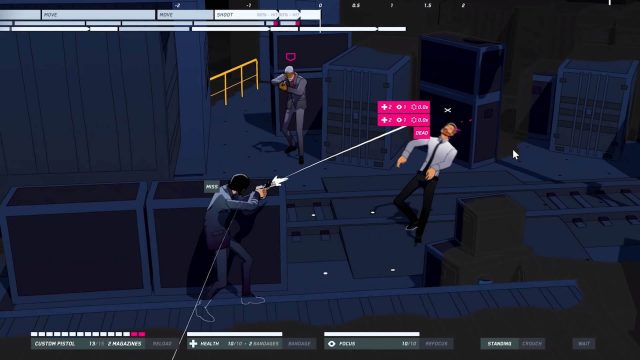
I love John Wick. Not the guy necessarily, I mean he’s cool but I don’t know him. But the films. Visceral, stylistic action. Brutal. So a John Wick game could really be something. But what if it wasn’t what you expected, and instead of a third-person shooter it’s a tactical turn-based game…. what if indeed…
John Wick Hex tells the story of an event from before the films when Wick was at his prime. Ian McShane and Lance Reddick reprise their roles from the films but sadly there is no Keanu – Wick is silent here. Told through the perspective of Hex – the bad guy in this tale in dialogue with the other stars, Wick is purely there as a puppet of destruction. The Hex villain’s namesake has a double meaning though – everything in John Wick Hex is played out on a board of hexagonal places.
A strategy game then, and it works surprisingly well. However first impressions of it being a turn-based strategy game are deceiving. It’s a time-based strategy game. Every move you make costs you a certain amount of time and is reflected in the timeline at the top of the screen. Walk a hex – a very small amount of time. Shoot a gun – maybe a second. Parry a strike? Very quick, half a second. You get the idea. The baddies have similar timelines that sit below yours, so you can see what they’re about to do and plan accordingly based on how much time your moves will take.
This takes some time to get your head around. Like Superhot, which is probably the best comparison, time is really only moving when you are. So you have as much time as you want to assess enemy movements – fortunately, when you interrupt the path or spot an enemy, the action is interrupted too so you don’t have to worry too much about the world moving along without you and not having time to make a decision.

What this enables is an entire suite of Wick style actions. My first impressions were not great – the things that Wick is able to do feel quite limited. Parry, strike, push, takedown, throw gun or shoot are all Wick is able to do. But it isn’t the variety of what John Wick does, it’s how he chains it together whilst taking on multiple foes. Hex captures this well.
Each move has a benefit. Parry, for example, feels pointless early on, but it’s a very quick move which stuns an opponent. Similarly, lining up a shot costs you time and ammo, but throwing your gun is quick although disarms you. Once you get into your first real multi-person fight it all clicks and is brilliant. You’ll walk into an area, shoot one guy, strike another, then push him back to move out of harm’s way. Maybe then you throw your gun at one, takedown another but more so to position yourself again a wall to allow for some cover. At the end of the level, you get a real-time replay of what you’ve done.
These replays are cool but they could be smoother. By that, I mean that you’ll watch Wick move across the hexagonal places to tackle enemies, but it has a hilarious disjointed zigzag walking. It’s a minor niggle. The art style helps pass this off to a degree – everything is very… John Wick. Not that John Wick would be seen in pink – he’s basically all black all day. But the start contract of white text on black and grey backgrounds with pink highlights strikes a chord. It looks good and as Wick is infiltrating Chinatown or high-end nightclubs, it all works.
The semi top-down viewpoint also is essential in tactical planning, but the cell-shaded nature of it meant I struggled at times to properly ascertain if I were in cover or not. Games like XCOM give you a shield icon to tell if you’re shielded by cover, but this doesn’t. John can crouch to get behind things, but you need to consider if that is going to give you the cover needed. Fortunately, a ‘fog of war’ meaning that you can only see what Wick would see help, but on a map that’s already very dark, adding a completely black area is sometimes confusing.
The levels are very challenging. Each stage is wrapped up in a narrative location (for the one being the aforementioned Chinatown) and you carry your equipment, ammo and health to the next stage. This continues until all are done, which adds to the challenge but doesn’t make it at all easy when you scrape through a particularly hard stage and don’t have any health for the remaining ones.
Trial and error is a useful approach here, as before each world you can stash equipment (guns) or bandages in places where you may need them. The harder it would be to infiltrate in real life (for example, the boss’s office) the more this ‘costs’ you in terms of finite allocation points. Only after playing the stages will you know where you’re most likely to need these things though, so it’s not so much about forward planning as it is from remembering the frustration of where you died previously.
The coolness of John Wick meets the frustration of the challenge is ever in limbo in John Wick Hex. I flicked between loving it and feeling that it’s just a little bit too difficult for me to really enjoy it. When it works, and it flows, it’s brilliant. When it isn’t working you can’t help but feel there are some design flaws here, but that may be reflective of my ability as I can’t think of an easy way to fix them.
Reviewed on PS4


Leave a Reply